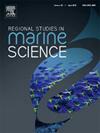Arsenic, cadmium, copper and zinc in two marlin species from the southern Gulf of California: Risk assessment and variations with environmental factors
IF 2.4
4区 环境科学与生态学
Q3 ECOLOGY
引用次数: 0
Abstract
This study assesses the health risks of As, Cd, Cu, and Zn in 109 specimens of Makaira nigricans and 461 specimens of Kajikia audax from the Gulf of California between 2007 and 2015. Analysis were made by inductively coupled plasma![]() optical emission spectrometry (ICP
optical emission spectrometry (ICP![]() OES). Anomalies of SST and Chl-a were obtained from composite satellite images. The ONI values were obtained from the NOAA. Multivariate methods using Euclidean distances were used to analyze the relationship of elemental concentrations with species variables and environmental factors using Principal Components Analysis (PCA) and hierarchical agglomerative clustering. Average median concentrations (µg g-1 wet weight) in M. nigricans were Zn (6.480) > As (0.405) > Cu (0.316) > Cd (0.044), and in K. audax Zn (7.228) > As (1.445) > Cu (0.355) > Cd (0.099). As concentrations peaked in 2012 (M. nigricans) and 2013 (K. audax), while Cd levels declined in 2014–2015 (K. audax). In M. nigricans, Cu concentrations were significantly lower in 2014 while in K. audax Cu levels were significantly lower in 2014. With respect to Zn, concentrations of K. audax were significantly higher in 2012 and 2013. Total hazard quotients (HQ) values were below risk thresholds. In M. nigricans Zn increased significantly with Cu, As and Cd and Cu with As and Cd. In K. audax Cu increased with As and Cd, Zn increased with Cu and As with Cd. Elemental concentrations varied with Chl-a; Cd levels increased in M. nigricans, while Cu and As levels increased in K. audax. In M. nigricans Cu increased with LJFL and total weight. In K. audax, As, Cd and Zn increased with LJFL and total weight. Correlations were confirmed by PCA. Cluster and SIMPROF analysis revealed that Cd, Cu and Zn had similar patterns in both species; however, As was significantly higher in the striped marlin.
OES). Anomalies of SST and Chl-a were obtained from composite satellite images. The ONI values were obtained from the NOAA. Multivariate methods using Euclidean distances were used to analyze the relationship of elemental concentrations with species variables and environmental factors using Principal Components Analysis (PCA) and hierarchical agglomerative clustering. Average median concentrations (µg g-1 wet weight) in M. nigricans were Zn (6.480) > As (0.405) > Cu (0.316) > Cd (0.044), and in K. audax Zn (7.228) > As (1.445) > Cu (0.355) > Cd (0.099). As concentrations peaked in 2012 (M. nigricans) and 2013 (K. audax), while Cd levels declined in 2014–2015 (K. audax). In M. nigricans, Cu concentrations were significantly lower in 2014 while in K. audax Cu levels were significantly lower in 2014. With respect to Zn, concentrations of K. audax were significantly higher in 2012 and 2013. Total hazard quotients (HQ) values were below risk thresholds. In M. nigricans Zn increased significantly with Cu, As and Cd and Cu with As and Cd. In K. audax Cu increased with As and Cd, Zn increased with Cu and As with Cd. Elemental concentrations varied with Chl-a; Cd levels increased in M. nigricans, while Cu and As levels increased in K. audax. In M. nigricans Cu increased with LJFL and total weight. In K. audax, As, Cd and Zn increased with LJFL and total weight. Correlations were confirmed by PCA. Cluster and SIMPROF analysis revealed that Cd, Cu and Zn had similar patterns in both species; however, As was significantly higher in the striped marlin.
来自加利福尼亚湾南部的两种马林鱼的砷、镉、铜和锌:风险评估及其随环境因素的变化
本研究评估了2007 - 2015年加利福尼亚湾109个马凯拉黑鲈和461个卡吉基亚黑鲈样本中As、Cd、Cu和Zn的健康风险。采用电感耦合等离子体发射光谱法(ICPOES)进行分析。海温和Chl-a的异常由卫星合成图像得到。ONI值来自NOAA。采用欧几里得距离多元分析方法,采用主成分分析(PCA)和层次聚类分析方法,分析了元素浓度与物种变量和环境因子的关系。平均中位浓度(µg g-1湿重)为Zn (6.480) >;As (0.405) >;Cu (0.316) >;Cd (0.044), K. audax Zn (7.228) >;As (1.445) >;Cu (0.355) >;Cd(0.099)。Cd浓度在2012年(黑曲霉)和2013年(黑曲霉)达到峰值,2014-2015年(黑曲霉)下降。2014年黑穗病菌铜浓度显著降低,黑穗病菌铜浓度显著降低。在Zn方面,2012年和2013年黑檀的浓度显著升高。总危险商(HQ)值低于风险阈值。在黑马中,Zn随Cu、As和Cd显著升高,Cu随As和Cd显著升高。在黑马中,Cu随As和Cd升高,Zn随Cu和As随Cd升高。黑僵菌的Cd水平升高,黑僵菌的Cu和As水平升高。在黑僵菌中,Cu随LJFL和总重的增加而增加。As、Cd、Zn随LJFL和总重的增加而增加。通过主成分分析证实相关性。聚类分析和SIMPROF分析表明,Cd、Cu和Zn在两个物种中具有相似的模式;然而,条纹马林鱼的As明显更高。
本文章由计算机程序翻译,如有差异,请以英文原文为准。
求助全文
约1分钟内获得全文
求助全文
来源期刊

Regional Studies in Marine Science
Agricultural and Biological Sciences-Ecology, Evolution, Behavior and Systematics
CiteScore
3.90
自引率
4.80%
发文量
336
审稿时长
69 days
期刊介绍:
REGIONAL STUDIES IN MARINE SCIENCE will publish scientifically sound papers on regional aspects of maritime and marine resources in estuaries, coastal zones, continental shelf, the seas and oceans.
 求助内容:
求助内容: 应助结果提醒方式:
应助结果提醒方式:


